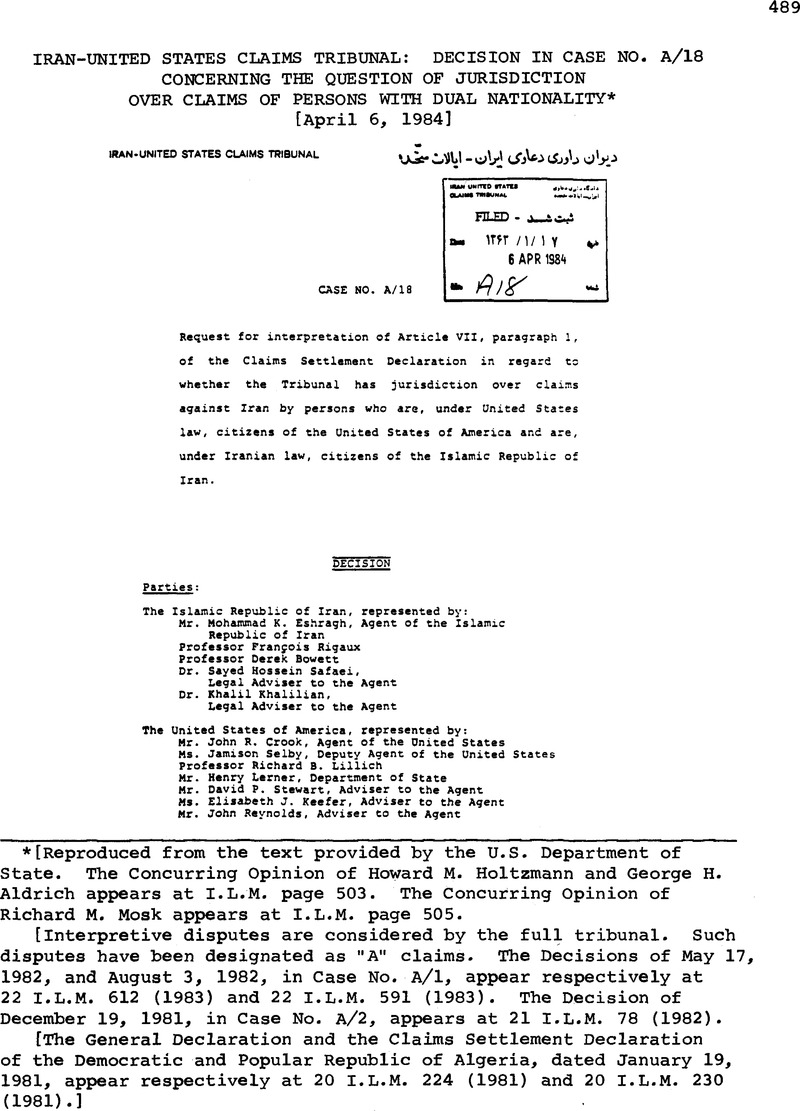Published online by Cambridge University Press: 04 April 2017

[Reproduced from the text provided by the U.S. Department of State. The Concurring Opinion of Howard M. Holtzmann and George H. Aldrich appears at I.L.M. page 503. The Concurring Opinion of Richard M. Mosk appears at I.L.M. page 505.
[Interpretive disputes are considered by the full tribunal. Suchdisputes have been designated as“A”claims. The Decisions of May 17,1982, and August 3, 1982, in Case No. A/1, appear respectively at22 I.L.M. 612 (1983) and 22 I.L.M. 591 (1983). The Decision ofDecember 19, 1981, in Case No. A/2, appears at 21 I.L.M. 78 (1982).
[The General Declaration and the Claims Settlement Declarationof the Democratic and Popular Republic of Algeria, dated January 19,1981, appear respectively at 20 I.L.M. 224 (1981) and 20 I.L.M. 230(1981).]
1 Declaration of the Government of the Democratic and Popular Republic of Algeria concerning the Settlement of Claims by the Government of the United States of America and the Government of the Islamic Republic of Iran.
2 Decision in Case A–l, Issue 1, dated 30 July 1982.
3 U.N. Doc. A/CONF. 39/27, 23 May 1969; reprinted in 8 I.L.M. 679 (1969).
4 Id. Article 31(1).
5 As stated in the Memorandum of State Department Assistant Legal Adviser George Spangler dated 19 February 1962 which was submitted by the United States at the Hearing.
6 Article V of the Claims Settlement Declaration provides:The Tribunal shall decide all cases on the basis ofrespect for law, applying such choice of law rules andprinciples of commercial and international law as theTribunal determines to be applicable, taking intoaccount relevant usages of the trade, contract provisionsand changed circumstances.
7 The Panevezys–Saldutiskis Railway Case, PCIJ, Series A/B, No. 76 (1939) 4, 16.
8 Compare the decision of the European Commission of Human Rights holding that the Allied–German Supreme RestitutionCourt in the Federal Republic of Germany, which applies andinterprets German law, is an international tribunal. IIYearbook of the European Convention on Human Rights, 288(1958–1959).
9 See Borchard, E.M. The Diplomatic Protection of Citizens Abroad 588 (1927)Google Scholar.
10 See Griffin,“International Claims of Nationals of Both the Claimant and Respondent States – The Case History of aMyth,” 1 The International Lawyer 400, 402 (1966–67) and theState Department Memorandum prepared by Mr. Griffin anddated 6 November 1957 which was submitted by the UnitedStates at the Hearing.
11 Nottebohm Case (Liechtenstein v. Guatemala) ICJ Reports (1955) 4, 22.
12 Basdevant, "Conflits de Nationalites dans les ArbitragesVenezueliens de 1903–1905”, Rev, de Droit Intern. Prive 41, 60–61 (1909).Google Scholar
13 The question of interpretation posed in this case by the Government of Iran relates only to claims against Iran;however, it follows that the reasoning in this Decision isequally applicable to any claims against the United States.
* Resolution 31/98, adopted 15 December 1976.
1 Declaration of the Government of the Democratic andPopular Republic of Algeria Concerning the Settlement ofClaims by the Government of the United States of Americaand the Government of the Islamic Republic of Iran.
2 I also agree with the concurring opinion of MembersHoltzmann and Aldrich and write this separate opinion onlyto expand upon some of the points they make.
3 Claims Settlement Declaration and Declaration of theGovernment of the Democratic and Popular Republic ofAlgiers (‘General Declaration’) and the relatedUndertakings.
4 General Principle B states:“It is the purpose of bothparties, within the framework of and pursuant to theprovisions of the two Declarations of the Government ofthe Democratic and Popular Republic of Algeria, to terminateall litigation as between the government of eachparty and the nationals of the other, and to bring aboutthe settlement and termination of all such claims through binding arbitration.”
Article VII, paragraph 2 provides:“Claims referred tothe Arbitral Tribunal shall, as of the date of filing ofsuch claims with the Tribunal, be considered excluded frontthe jurisdiction of the courts of Iran, or of the UnitedStates, or of any other court.”
5 Despite the language of the Algiers Declarations, Iranhas argued that even if the Tribunal does not havejurisdiction over a claim by a“dual national”, the claimcannot be maintained in United States courts.
6 In spite of the surnames of the claimants in thosecases, Iran contends it did not necessarily know of the dual nationality” of such claimants. Nevertheless, Iran's failure at that time even to suggest a distinctionbetween United States citizens who were“dual nationals”and those who were not, indicates that Iran was moreinterested in the termination of United States litigationthan in the possibility that“dual nationals” could bringclaims before the Tribunal.
7 Iranian citizens cannot abandon their nationality until,inter alia, they reach the“full age” of 25, they have theapproval of the Council of Ministers and they make arrangements to transfer to Iranian nationals all rightsin real property in Iran (including that which they“mayacquire by inheritance”). Those who renounce theirIranian nationality must leave Iran or be expelled, andsuch persons can only thereafter visit Iran once, and then, only with“special permission” from the Council ofMinisters. Article 988 of the Iranian Civil Code. Thefollowing are examples of those who are deemed Iraniannationals: a woman who marries an Iranian national;children of an Iranian father; and those who have a parentof foreign nationality, and who are born in Iran and whocontinue to reside in Iran for one year immediately afterreaching the full age of 18. Article 976 of the Iranian Civil Code.
8 As to whether Iranian nationality laws conform toaccepted international standards, see, e.g.. Art. 9(1),Convention on the Elimination of ATI Forms of DiscriminationAgainst Women, December 18, 1979, entered intoforce Sept. 3, 1981, G.A. Res. 34/180 (annex), 34 U.N.GAOR Supp. (No. 46) at 193, U.N. Doc. A/Res/34/180 (1980),reprinted in 19 I.L.M. 33 (1980); Art. 15(2); UniversalDeclaration of Human Rights, G.A. Res. 217, u.N. Doc.A/180 at 71 (1948).